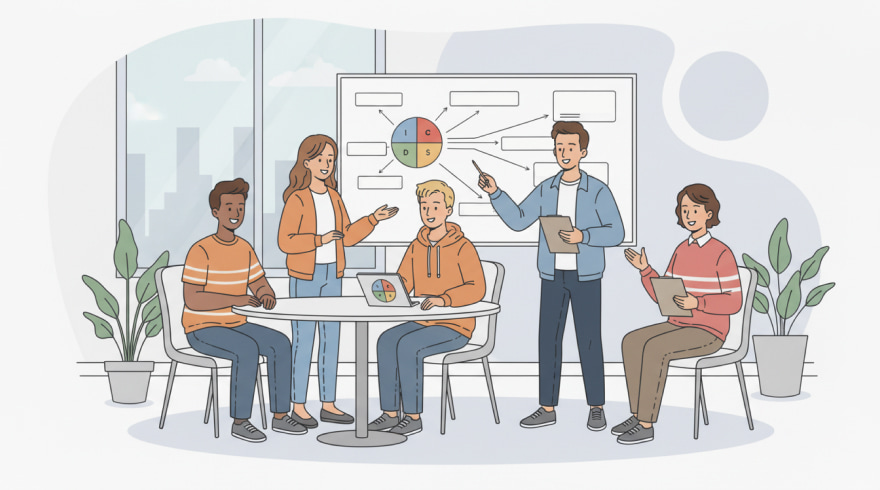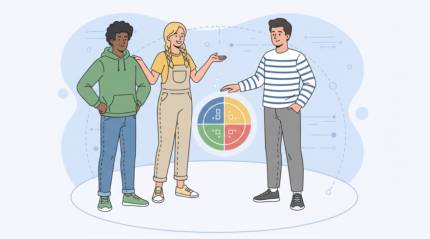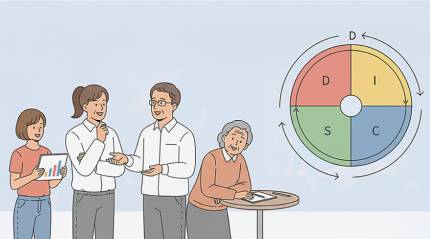The Complete DISC Guide for Clear Communication and Confident Growth
- 8 October 2025

People make sense of one another through patterns, signals, and context, and the DISC model offers an approachable method to decode those cues. Developed from longstanding behavioral research, this framework clarifies how pace, priority, and problem-solving preferences shape what others see. Rather than boxing anyone into a rigid label, it highlights tendencies under stress and calm, so you can flex wisely across situations. Teams adopt it to reduce friction, managers lean on it to coach with finesse, and individuals use it to articulate needs without guesswork.
Across research-backed models in organizational psychology, the DISC personality framework offers a fast lens many practitioners trust today. It breaks behavior into four recognizable patterns Dominance, Influence, Steadiness, and Conscientiousness and shows how each pattern contributes unique strengths. You can apply these insights to meetings, feedback, hiring conversations, and customer interactions, ultimately creating smoother collaboration. With a shared language for behavior, misunderstandings shrink, and confidence expands through clear expectations and practical tools that scale.
Professionals often begin with a brief overview before moving into measurement and dialogue that deepens the learning journey. In structured programs, the DISC personality assessment serves as a starting point for DISCovery and sets the stage for coaching. The value emerges when participants reflect on triggers, compare preferences, and decide on micro-behavior shifts they can practice immediately. When you combine insight with action, the model becomes more than an idea; it becomes a reliable rhythm for communicating with intention.
- Clarify communication preferences without judgment.
- Reduce rework by aligning expectations in advance.
- Improve feedback quality and coaching precision.
- Strengthen trust by making needs explicit and observable.
The Four Styles Explained
Each DISC style blends a typical pace with a typical priority, and the mix influences how work gets done. Dominance leans into results, Influence energizes people, Steadiness stabilizes processes, and Conscientiousness elevates accuracy. None is superior; the power lies in knowing when each is most useful, and how to adapt under pressure. Context matters as much as preference, because an effective communicator can flex tone, detail, and speed when conditions shift.
Because descriptions can feel abstract, practitioners demonstrate behaviors with concrete scenarios that reveal triggers and strengths. Trainers often package findings in a DISC personality inventory report that maps intensity across factors. When people see their everyday habits mirrored in charts and examples, the labels lose their edge and turn into practical guides. This is where storytelling, role play, and debrief questions transform theory into repeatable skill.
Beyond the headline style, nuance appears in priorities such as action, enthusiasm, support, or precision across different tasks. Many programs visualize these nuances through a DISC personality profile summary that highlights situational tendencies. You might show assertiveness in negotiations yet switch to meticulous analysis when scoping a project. That variability is normal, and it is exactly why situational flexibility becomes the hallmark of mature communicators who lead with awareness.
- Dominance: decisive, direct, and challenge-ready.
- Influence: outgoing, persuasive, and story-driven.
- Steadiness: patient, reliable, and relationship-focused.
- Conscientiousness: analytical, careful, and quality-oriented.
Benefits for Work, Leadership, and Relationships
Organizations seek scalable ways to improve collaboration, and DISC delivers adaptable language that fits many roles. The model helps people anticipate friction points, such as speed versus detail, and negotiate a balance before work begins. In hybrid settings, the benefits multiply because clarity around expectations prevents remote misunderstandings and slows the escalation of minor issues. Leaders who translate preferences into explicit working agreements see engagement rise and rework decline across projects.
For operational results, teams embed checkpoints that honor style differences without slowing momentum. Managers appreciate how a DISC personality assessment tool integrates with onboarding plans and performance conversations. Customer-facing staff benefit by mirroring tone and depth, reducing the risk of overselling or undersharing. When everyone knows the signals to watch for, they can tailor communication and deliver value with less friction and fewer surprises than before.
Skill-building sticks when learning is active, reflective, and reinforced in rhythm with daily work. Many teams introduce short learning sprints that include a DISC personality quiz used to spark DISCussion about real calls, meetings, or emails. Those micro-moments help people connect theory to practice while building a shared library of examples. Over time, the language becomes second nature, and the culture shifts toward empathy, clarity, and coordinated action that sustains performance.
- Faster project starts through aligned expectations.
- Cleaner handoffs that respect style differences.
- Better conflict recovery with agreed-upon repair steps.
- Stronger customer rapport through adaptive messaging.
How to Administer, Interpret, and Apply Results
Launching a DISC program works best when you blend solid facilitation with clear privacy principles. Start by explaining the purpose, then set norms that focus on behavior rather than personality judgments. After participants complete the instrument, schedule a debrief that covers strengths, blind spots, and practical adjustments they can try immediately. Follow-up sessions a few weeks later help teams normalize new habits and keep momentum steady.
Administration can be simple if you frame each step with transparency and care for context and consent. In structured implementations, participants complete a DISC personality test questionnaire that captures preferences across typical workplace situations. The facilitator then synthesizes insights into visuals and stories that make the data relevant to current goals. When people feel seen and respected, they engage fully with practice scenarios and transfer learning to real projects quickly.
Interpreting reports requires nuance so labels do not limit growth or excuse poor behavior under pressure. Coaches often complement reports with DISC personality profile testing DISCussions that unpack triggers and situational shifts. By linking insights to role demands, teams move beyond novelty and into everyday execution where communication really counts. The most effective programs include simple rituals like meeting check-ins that keep adaptation front and center.
| Style | Typical Pace | Primary Focus | Common Blind Spot |
|---|---|---|---|
| Dominance | Fast | Results | May overlook input |
| Influence | Fast | People | May skip details |
| Steadiness | Moderate | Support | May resist change |
| Conscientiousness | Deliberate | Quality | May slow decisions |
- Introduce shared definitions before reviewing results.
- Use real scenarios to practice language adjustments.
- Reinforce with brief check-ins at project milestones.
- Protect privacy and avoid labeling people as fixed types.
Choosing a Reliable Platform and Ethical Use
Before purchasing a solution, clarify your goals, timelines, and privacy expectations so selection aligns with values. Look for evidence-based instruments, clear technical documentation, and accessible reporting formats suited to your audience. Data handling should be transparent, with options to delete records and limit access to sensitive information. Vendors should also provide facilitation guidance to ensure participants feel respected and empowered throughout the process.
When comparing options, evaluate the philosophy behind each provider and how they support responsible use at scale. Many HR leaders appreciate a DISC personality types test that balances accuracy with clear, plain-language debriefs. The best tools help users translate insights into daily routines rather than producing shelfware. You can pilot with a small cohort, gather feedback, and refine rollout plans to match culture and business rhythms.
Budgets matter, and so does equity of access when planning broad learning initiatives across distributed teams. Some organizations begin with a paid pilot while others first explore a DISC personality test free resource to preview language. Regardless of entry point, the ethical lens stays the same: avoid pigeonholing people, protect privacy, and emphasize growth. With those guardrails in place, the investment returns as trust, speed, and better decisions across the system.
- Verify reliability and validity documentation.
- Check admin controls for privacy and data retention.
- Align report depth with your audience’s needs.
- Provide manager training to prevent misuse.
FAQ: Your Top Questions Answered
- How accurate is DISC compared to other behavioral models?
Accuracy depends on proper administration, thoughtful facilitation, and realistic expectations about what behavioral frameworks can deliver. The model is strongest when used as a shared vocabulary for observable patterns rather than as a rigid typology. Coaches who emphasize situational flexibility help participants avoid stereotyping and keep the focus on practical communication skills. With reflective debriefs and follow-up practice, teams translate insights into better meetings, cleaner handoffs, and quicker conflict recovery.
- Can I try DISC without committing to a full rollout?
Pilots work well, especially when you define clear success criteria and select a representative group to test logistics. Many learning leaders start with a small cohort and then scale based on feedback about clarity, usefulness, and engagement. Some also explore a DISC personality types test free option to sample the language before investing in facilitated sessions. Whatever the path, the most important piece is treating the experience as a skill-building journey rather than a one-off event.
- What is the best way to debrief results with a team?
Begin with norms that reduce defensiveness and underscore the goal of mutual understanding over judgment. Use real scenarios like status updates, brainstorming, or feedback to help people apply new language immediately. Facilitators often combine reflection prompts with small-group role plays to keep energy high and insights practical. Over time, teams that ritualize adaptation gain speed because expectations become explicit and recoveries from misfires become faster.
- Are there downloadable resources I can share with colleagues?
Resource hubs, worksheets, and quick-reference cards can reinforce learning when curated thoughtfully by a facilitator. Many vendors publish guides, use cases, and case studies that demonstrate practical applications across industries and roles. Some providers include a DISC personality test free download option that makes sharing introductory material simple for pilot programs. Focus on materials that translate concepts into actions so the knowledge moves from slides into everyday conversations.
- How should managers use DISC in coaching conversations?
Managers can frame coaching around strengths, triggers, and small experiments that match each person’s role demands. It helps to invite self-assessment, agree on observable behaviors to practice, and define a clear follow-up cadence. Avoid oversimplifying decisions or delegating based only on style, because growth requires stretch assignments and supportive feedback. When leaders model flexibility and curiosity, the entire team benefits from clarity, empathy, and smoother collaboration across projects.



